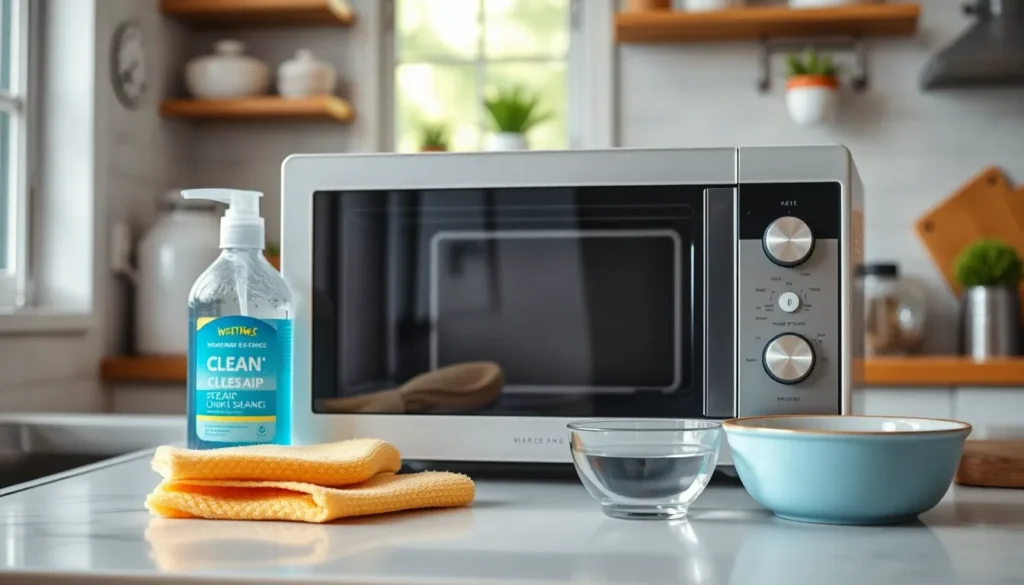Table of Contents
ToggleA clean microwave filter is essential for maintaining the efficiency and longevity of this kitchen staple. Over time, grease and food particles accumulate, blocking airflow and reducing the appliance’s performance. Regular maintenance not only enhances cooking efficiency but also ensures a healthier cooking environment by minimizing odors and smoke.
Cleaning the microwave filter might seem daunting, but it’s a straightforward task that anyone can tackle. With just a few simple steps and common household items, anyone can restore their filter to its optimal condition. This guide will walk through the process, making it easy to keep that essential kitchen tool in top shape.
Understanding Microwave Filters
Microwave filters play a crucial role in maintaining appliance efficiency by trapping grease and food particles. Understanding their purpose and types enhances a user’s ability to keep the microwave in optimal working condition.
Purpose of Microwave Filters
Microwave filters serve two primary functions: improving air quality and enhancing cooking efficiency. Filters capture grease, smoke, and odors, which prevents them from circulating in the kitchen. Clean filters maintain proper airflow, reducing strain on the microwave’s motor and prolonging its lifespan. Regular maintenance of these filters contributes to a healthier cooking environment.
Types of Microwave Filters
Microwave filters generally fall into two categories:
- Charcoal Filters
Charcoal filters absorb odors and smoke. They usually require replacement after a specific time, often about every six months, to maintain effectiveness.
- Grease Filters
Grease filters capture grease and food particles. These filters can be cleaned and reused, typically once every one to two months, depending on usage.
Understanding these types helps users determine cleaning frequencies and replacement needs, ensuring the microwave functions properly.
Benefits of Cleaning Microwave Filters

Cleaning microwave filters offers significant benefits that enhance both appliance performance and kitchen hygiene. Regular maintenance contributes to optimal functionality and a healthier cooking environment.
Improved Efficiency
Improved efficiency results from clean microwave filters. Clean filters facilitate better airflow, allowing microwaves to cook food evenly and effectively. Clogged filters or accumulated grease slow down air circulation. Enhanced airflow reduces the workload on the microwave’s motor, extending its lifespan and making energy consumption more efficient. Users can also expect faster cooking times due to improved heat distribution.
Enhanced Food Safety
Enhanced food safety is another critical benefit of clean microwave filters. Grease and food particles trapped in dirty filters create a breeding ground for bacteria and other pathogens. Maintaining clean filters minimizes the risk of food contamination, ensuring safer meal preparation. This proactive approach promotes a healthier kitchen environment, allowing users to cook without concerns about harmful substances affecting their food.
Preparation for Cleaning
Preparation is essential for effectively cleaning a microwave filter. Gathering the necessary materials and ensuring safety will make the process smoother.
Required Materials
- Dish soap – Non-abrasive dish soap helps break down grease.
- Warm water – A mixture of warm water and dish soap creates an effective cleaning solution.
- Soft cloth or sponge – A non-scratch cloth or sponge avoids damaging the filter.
- Baking soda – This acts as a natural abrasive and deodorizer for tough residues.
- Toothbrush – A soft-bristled toothbrush cleans hard-to-reach areas.
- Bucket or bowl – This holds the cleaning solution for easy access.
- Rubber gloves – These protect hands from grease and cleaning agents.
Safety Precautions
- Unplug the microwave – Disconnecting it from power prevents accidents while cleaning.
- Allow the microwave to cool – Waiting for the appliance to cool ensures safe handling of parts.
- Wear gloves – Using rubber gloves protects skin from strong cleaning solutions and grease.
- Avoid using abrasive materials – Steer clear of steel wool or harsh scrubbers to prevent scratches on the filter.
- Read the manufacturer’s instructions – Checking the manual provides specific guidance for cleaning methods and materials.
Step-by-Step Guide on How to Clean Microwave Filter
Cleaning the microwave filter involves several straightforward steps. Following this guide ensures effective maintenance and optimal performance of the microwave.
Removing the Filter
- Locate the Filter: Identify the microwave filter’s location. Typically, it’s situated beneath the microwave’s ventilation hood or on the side.
- Unclip or Slide Out the Filter: Depending on the model, unclipping or sliding out the filter requires gentle hand pressure. Consult the user manual if unsure about the process.
- Inspect for Damage: Check the filter for any signs of wear or damage. Replace it if necessary, especially in the case of charcoal filters.
Cleaning Methods
- Prepare a Cleaning Solution: Mix warm water with a few drops of non-abrasive dish soap in a bowl or bucket.
- Soak the Filter: Submerge the grease filter in the solution. For stubborn grease, add 1-2 tablespoons of baking soda to the mix.
- Scrub Gently: Use a soft cloth or sponge to scrub the filter gently. Avoid abrasive materials that might damage the filter.
- Rinse Thoroughly: Rinse the filter under running warm water to remove soap and loosened grease. Ensure no residue remains.
- Dry Completely: Set the filter on a clean towel to air-dry completely before reinstallation. Moisture can lead to the growth of bacteria and reduce efficiency.
- Re-install the Filter: Once dry, reinstall the filter by sliding or clipping it back into place, ensuring a secure fit.
Drying and Reinstalling the Filter
Drying the microwave filter ensures no moisture remains, preventing mold and ensuring optimal performance. After rinsing the filter thoroughly, shake off excess water, allowing it to dry completely. Place the filter on a clean, dry towel in a well-ventilated area.
Checking for complete dryness before reinstalling is crucial. Moisture can create unpleasant odors and affect air quality. Wait at least one hour or until the filter feels dry to the touch.
Reinstalling the filter is straightforward. Slide the filter back into its designated slot or clip it securely into place. Ensure it fits snugly, preventing any gaps that could disrupt airflow.
Consulting the manufacturer’s instructions can provide additional guidance on the reinstallation process if needed. Confirm that the filter aligns properly, ensuring it functions effectively during use. Proper reinstallation maintains the microwave’s efficiency and prolongs its life.
Common Mistakes to Avoid
Cleaning the microwave filter improves appliance performance. Avoiding common mistakes during this process ensures effective maintenance.
Using Abrasive Cleaners
Using abrasive cleaners can damage the filter. Abrasive materials scratch surfaces and can reduce filter effectiveness. Instead, opt for non-abrasive dish soap mixed with warm water for safe and thorough cleaning. A soft cloth or sponge works best for gentle scrubbing, preserving the integrity of the filter.
Neglecting Regular Maintenance
Neglecting regular maintenance leads to buildup of grease and debris. This buildup impairs airflow and reduces cooking efficiency. Setting a cleaning schedule for grease filters every one to two months and charcoal filters every six months ensures optimal performance. Regular checks prevent problems and extend the filter’s lifespan, maintaining a healthier kitchen environment.
Maintaining a clean microwave filter is essential for optimal appliance performance and a healthier cooking environment. Regular cleaning not only enhances air quality but also improves cooking efficiency by ensuring proper airflow. By following the simple steps outlined in the article and adhering to a cleaning schedule, users can prolong the lifespan of their microwave and reduce the risk of food contamination.
Taking a few minutes every month to care for the filter can lead to significant improvements in cooking results and energy efficiency. With just a little effort, anyone can keep their microwave filter in top condition, ensuring a safe and efficient kitchen experience.








